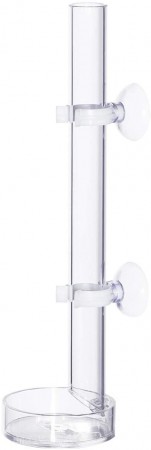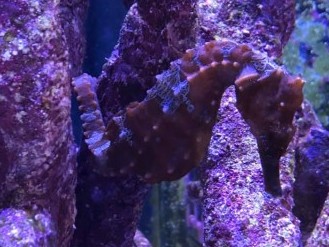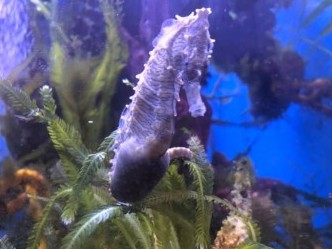Seahorses - Everything You Need to Know Guide About Seahorses
- Mar 25, 2020
- PalaciosAn
- 5511 0 0

Seahorses are amazing to watch, from their slender body shape and unique shaped head that looks similar to a horse (giving it its common name), to their unique swimming style, movements, and behaviors. Even without a tail fin like most fish, the seahorse can make some impressive maneuvers and hover in place for an extensive amount of time. While eating, seahorses will make a clicking noise. They also make noises to communicate or greet one another. Each of their eyes can move independently on either side of their head. They give seahorses excellent eyesight, giving them the ability to look forwards and backward at the same time. These are just a few of the things that make seahorses amazing.
[Picture was taken by Heidi Schroeder]
The seahorse's mouth has a uniquely its elongated snout sucks small prey in at remarkable speeds. While they may have little mouths, they can eat small fish and aquarium shrimp.
There are over 60 different species of seahorses around the world, and most of their characteristics do not vary much, but they can vary in colors. Whatever you do, do not buy a seahorse based on their color alone. A seahorse can change its color when it's stressed out and when it's ready to breed. Their skin has patterns on it called saddle markings, and these markings can become lighter or darker to help them camouflage themself.
Seahorses can't swim fast. They have fewer fins than most adult fish. Their back fin helps them navigate around using their side fins to turn. They are not the strongest swimmers and tend to stay away from heavy currents. Unlike regular fish, seahorses tend to stay put and will use their tail to hitch themself to something to keep them in place.
Aquacultured Seahorses
Keeping seahorses was once considered a challenging task. Wild-caught species are still difficult to feed as some will only accept live food, and some do not eat at all and eventually die off. As is, wild-caught seahorses tend to have a shorter lifespan in an aquarium.
Tank raised, or aquacultured seahorses made a huge difference. While still a damaging species to keep and not suggested for someone just starting in the hobby. Tank raised seahorses are healthier, more adaptable to tank life. They are taught to eat frozen food or even prepared food right away, making feeding them much easier. They also have a much longer lifespan, and more importantly, they are not being picked out of the wild.
How big do Seahorses get?
A seahorse height is measured from the tips of their curly tails to the tops of their bony heads. Each species of seahorses' size will vary, the average seahorse is around 5-7 inches, but you can find species as small as 1/2 inch to the largest seahorse, which is over a foot long, measuring almost 14 inches.
Are seahorses considered fish?
After years of debate, scientists have decided, yes, seahorses are considered to be fish. When you think of fish, you probably do not think of seahorses, and when you look at seahorses, you may not think of fish due to their unique body style.
Seahorses are close relatives to the tuna and trout species. They belong to the class Actinopterygii (bony fish), which also includes salmon and swordfish, and the family Syngnathidae (fused-jawed fish), which includes pipefish and seadragons. All seahorses belong to the genus Hippocampus. The word Hippocampus comes from two Greek words that mean "horse" and "sea monster."
They have a swim bladder that helps them control their buoyancy and interlocking plates on their exterior body. The only thing covering their boney spine is their skin, how they do not have any scales, so they are more susceptible to bacterial or viral infections.
They have four total fins, but unlike fish, they do not have a fin on the tip of their tail. Their fins are located behind both of their cheek as well as one under their belly and the main one on their back.
How long do Seahorses live?
In an aquarium, the average lifespan recorded is between 4-6 years, but some hobbyists claim they have kept their seahorses longer, but this is rare. In the wild seahorses have a shorter lifespan on average of 2-4 years, larger seahorses tend to live longer than smaller seahorses.
Choosing the Right Seahorse
Seahorses are extremely sensitive to bacterial or viral infections. Ideally, you want to be able to observe the seahorse you are considering buying. Even if the seahorse passes all of the checkpoints, unfortunately, they can still die only a few days later. Here are a few things to look for to improve your initial success rate with seahorses.
- Make sure they are eating, ask them to feed them a little. You want to see them go after the food and eat it. Even new arrivals should start eating after 24 hours.
- If the seahorse shows any signs of disease, you want to avoid the seahorse. If one of the seahorses appears to have a disease, then avoid all of the seahorses in the tank.
If you are buying from an online vendor, you want to make sure that you are buying from someone with a good reputation and with a survival guarantee.
Diet & Feeding Seahorses
In the wild, seahorses will hitch themself onto something and patiently wait for amphipods, small crustaceans, or even small fish to come wandering near them. A seahorse does not have teeth, so when food comes near them, they move closer slowly, and once they are close enough, they will rapidly move their head forward while sucking down their prey whole. This type of feeding is called elastic recoil feeding. Seahorses have a rudimentary stomach and need to absorb nutrients to stay healthy continuously. They do not fully digest their food.
A new seahorse that is not eating can be a challenge to get it eating, and that is why they must be eating before you get them. Wild-caught seahorses are more challenging to get them to eat, captive-bred seahorses tend to be easier to get them to eat, and some of them will even eat prepaid food. Once you own the seahorse, their care needs begin, most of their care will come from feeding them.
A common mistake is to feed seahorses un-enriched brine shrimp, which causes the seahorse to deplete their reserved nutrients within and weaken the seahorse over time and making it more susceptible to bacterial or viral infections. Within as little as seven days of feeding un-enriched brine shrimp, you will start to see them weaken. Even with enriched brian shrimp, this should not be the only or primary source of food for your seahorses.
I like to use a turkey baster or an equivalent tool that allows me to target feed each seahorse. For a typical size adult seahorse, you want to feed them 3-4 brian shrimp or a 2-3 mysis shrimp at a time. The turkey baster also allows me to suck up any uneaten food. Throughout the day, they should eat 12-16 brian shrimp or 8-14 mysis shrimp. There are large seahorses that can eat more.
Broadcast feeding a seahorse tank can cause uneaten food to pollute the water. That is why I prefer to target-feed them and control the amount of food and only feed small amounts of food.
It's wise to turn off your filtration to avoid the food from getting sucked up into your filter.
Seahorses are always attracted to live foods like amphipods, copepods, brine shrimp, small live shrimp, or even small fish. It is wise to keep a good stock of amphipods and copepods in your tank to supplement manual feedings. Most people can only feed their seahorses twice a day so the active pods can provide the additional needed feedings to keep them healthy.
Ideally, you want to provide frequent small feedings versus less regular large feeding. In a perfect world, you want to allow them to eat throughout the day.
Feeding Stations
 Target feeding seahorses is a lot of fun, but eventually, you will come across a time point when you do not have time to sit there and feed the seahorse a single shrimp at a time. Feeding stations can become handy. A feeding station is anything that is shaped like a bowl from a small glass preparing dish to a clam shale or even if you have an indented area in your live rock. You can also buy feeding stations that are used for seahorses or shrimp that are colored or clear acrylic. Most of the feeding stations that you can purchase have a cylinder that attaches to the feeding station allowing you to drop the food into the tube that floats down to the feeding tray.
Target feeding seahorses is a lot of fun, but eventually, you will come across a time point when you do not have time to sit there and feed the seahorse a single shrimp at a time. Feeding stations can become handy. A feeding station is anything that is shaped like a bowl from a small glass preparing dish to a clam shale or even if you have an indented area in your live rock. You can also buy feeding stations that are used for seahorses or shrimp that are colored or clear acrylic. Most of the feeding stations that you can purchase have a cylinder that attaches to the feeding station allowing you to drop the food into the tube that floats down to the feeding tray.
You have to teach your seahorses to eat from the feeding stations, while this may sound like a complicated process if you ever tried to train an animal, but it is super simple. While you are targeting feeding your seahorse, feed them one shrimp at a time and keep releasing the shrimp closer to the feeding station. Then place a few shrimp in the feeding station. You may have to do this 2-3 times before they start to associate the feeding station with food. Eventually, you will be able just to put the shrimp in the feeding station, and the seahorse will come and eat. If you keep a good schedule, you will find that the seahorses will hang out around the feeding station when it's time to eat.
Proper Seahorse Tank Setup
The size of the aquarium needed will vary depending on the species of seahorse that you want. How seahorses are not very active; they do not need a huge aquarium. Some species of seahorses allow you to have a pair of seahorses in a tank as small as 20-gallons. While a small tank may sound like a good idea, I like to use a 60-gallon cube tank, which can serve the needs of just about every seahorse species. There is enough water volume to make the maintenance needed easier. Smaller tanks need to have religious maintenance schedules to keep the water quality good.
A good rule of thumb to determine the smallest tank for a seahorse tank is 30-gallons for a seahorse pair, and for every other couple, you want to add 10-gallons. So if you wished to keep two pairs, then a 40-gallon tank or if you wanted to keep three pairs a 50-gallon tank.
A seahorse aquarium is not much different then most marine aquariums or species only tank needs, while some species needs may vary some most of the requirements are the same. It all starts with a quality salt mix that fits your needs.
Lighting Requirements
Seahorses do not have any advanced lighting requirements, so even a standard fluorescent light strip. They do not prefer intense lighting needed for corals. This is an essential factor to take into consideration if you plan on adding any coral in the tank with the seahorses.
Temperature Requirements
Seahorses like cooler waters and temperatures between 74 and 76 degrees. This is an essential factor as well when considering any other species that you plan to keep in your tank. While some hobbyists maintain the temperatures needed with a chiller, or a simple fan pointing at the water should do the trick but will cause extra water evaporation.
Water Flow
Seahorses can be mesmerizing to watch them swim in an aquarium, while seahorse tanks should have low flow if you have an area with a little bit of flow they will be fine. You just want to make sure that 80% of the tank has low flow. Yes, when the seahorse hits a higher flow, you will see them fly off with the flow. It's ok, as long as they do not have to be in that flow all the time, as long as they are healthy, it will not hurt them. I have seen seahorses that play in the heavy flow areas. Keep in mind; I am not talking about a heavy flow that can pin the seahorse or make it difficult for them to get out of the flow.
Yes, they are not strong swimmers, so there is no need for strong water flow, but more importantly, you want to have proper circulation in the tank.
An excellent trick to adding a low flow but still produce a suitable circulation in your tank is to use a spray bar. So instead of having all of the flow of your return focused out of one point like you usually see. Attach a spray bar to the return, which is just a capped piece of plastic or PVC with many small holes, so instead of pushing all of the flow into one large point, it pushes the flow into many small holes breaking the flow out into many smaller spots. The more holes, the more the flow is broken out.
Seahorse Hitching Post

Hitching posts are essential to seahorses. It allows them to hold on to something enabling them to rest. They will spend most of the day with their tail wrapped around a hitching post. While they may look like they are not doing anything, they are looking around and hunting.
In the wild, it is common to find seahorses in the shallow waters near seagrass. The seagrass is a perfect area for seahorses where copepods to span, a place to hide, and the seagrass can make for an excellent hitching post.
You need to make sure there are enough hitching posts in your aquarium for all of your seahorses. Real and fake plants make great hitching posts for seahorses, while seagrass may not be available due to some species being protected and collection restrictions. There are still many macroalgae like Caulerpa (if allowed in your area), which is commonly used in refugiums or Red Gracilaria, which can add some color. The beautiful thing about using macroalgae is that they absorb nutrients helping you keep the water clean. Macroalgae will need to be trimmed from time to time to avoid taking over your aquarium.
Corals, on the other hand, do not make a good hitching post. Some corals can either sting the seahorse, or the seahorses can irritate or even kill corals.
Other useful hitching posts, while not natural but PVC and plastic chain, also works well.
Live Rock
Using live rock in a seahorse aquarium is perfectly fine. You need to be careful, though with live rock, as it can be an excellent source for introducing hitchhikers. While some hitchhikers can be useful, such as copepods and sponges, there are many more hitchhikers that are bad for seahorses like large bristle worms, mantis shrimps and crabs, which can cause you significant problems.
You want to make sure that the rock is cured correctly to avoid adding any pest to the aquarium that could hurt or even kill your seahorse.
Filtration Needs
The filtration is vital; maintaining good water quality will be critical to keeping healthy seahorses. If possible, using a sump with a low flow rated return pump. A sump may not be possible in some seahorse tank setups, but a simple hang-on-the-back (HOB) filter will also work. If you are considering a HOB filter, you want to make sure that you get one that is rated for at least twice the size of your aquarium water volume.
The seahorse's rudimentary stomach means that the seahorse does not digest the food that they eat, meaning more waste that can spoil the water quality. The ideal filtration system is a low flow filtration system, but it possesses its issues, such as low oxygen levels. Some solutions to low oxygen levels are adding a protein skimmer that allows you to filter out nutrients and oxygenate the water as well.
You can also add a low flow powerhead to the aquarium, which will help circulate the water in the tank more and help evenly distribute the oxygen levels and prevent dead spots.
Seahorse Tankmates
Seahorse do best in a species only aquarium, in the wild, they are mostly solitary creatures usually only found with their mates.
Fish
When considering a tankmate for your seahorse, you want to stay away from any type of aggressive, territorial, or very active species as they could pick on the seahorses, or they can out hunt the seahorse for its food and take all or most of the available food when presented.
So some tankmates you can consider are pipefish, dragonets, small gobies, firefish, Banggai/pajama cardinals, and royal grammas.
If possible, you want to add the seahorse to the aquarium first, let them settle in, and make sure they are eating well before introducing any species to the aquarium. Do not add too many fish and introduce a single species at a time.
Corals
Many corals have either stinging cells or stinging tentacles that can hurt, kill, or even trap a seahorse long enough for the coral to eat them. Just like fish, you want to avoid aggressive corals, especially anemones (invertebrate) or any stinging corals. How seahorses are not strong swimmers and anemone or large brain coral can easily make a meal of the seahorse. Most Large Poly Stoney (LPS) corals will not work either the corals large poly will sting the seahorse.
Most corals require medium to intense lighting, which seahorse does not like, many corals also like medium to high flow, which is also not ideal for a seahorse. So most corals will not survive in the type of environment needed for seahorses.
Also, while Gorgonians or Acropora corals may seem like the perfect hitching post for the seahorse, while this is true, note that the seahorse could damage the corals by irritating them.
Some corals that do well with low light and low flow that could do well with seahorses are Acans, Favites, Lobophyllia, Zoanthids, Star polyps, Mushrooms, and Ricordias.
Invertebrates
Most invertebrates will fall under two different categories. Either they will pick on the seahorse and could kill them, or they will become a food source for the seahorse. Typically, all crabs and hermit crabs are not a good idea as the crab is likely to pick on the seahorse. Small blue legged variety of hermit crabs are generally fine.
Most snails are safe in a seahorse tank and are part of a health tank to help keep things clean.
Seahorses will hitch on anything, including clams and scallops, when touched a clam or scallop is likely to close on the seahorses tail damaging or even causing them to lose their tail, which could lead to an infection.
Small shrimp will become a quick meal for your seahorse, and large shrimp will outcompete the seahorse and eventually starve out your seahorse.
Anemones do not belong in a seahorse tank. They will quickly sting and eat your seahorses. Anemones will love, so regardless of where you put them, the seahorse will most likely pass by them, or the anemone will move, possibly closer to the seahorse. Their tentacles are sticky, and if they touch the seahorse will sting them and will pull it towards the other tentacles and eventually eating them.
Sexing & Breeding Seahorses

Many seahorses bond or become mating partners for life, while this may sound romantic to many if you are a poor swimmer that realizes on being camouflage to avoid predators migrating from one area to another to find a mate can be quite dangerous. If their partner dies, then they will go out and find another mate. While this is true, for most seahorses, not all seahorses mate for life. The advantage of the life long bond is the ability to produce more fry how they do not have to find a mate.
It takes about 14 weeks for a seahorse to reach full maturity, and at that point, they can reproduce. Once they are mature, determining their sex is much easier. Unlike most animals, the males give birth to their young fry. Males have a brood pouch used to store the fertilized eggs, this pouch is located below the anial fin of male seahorse and is where they attach and become fertilized. Looking for the brood pouch is the best way to identify males from females.
Once the eggs are in the male's brood pouch, roughly 20 to 28 days later, he will give birth to the fry. This is usually done at night, and around the full moon period, the amount of surviving eggs can be anywhere from 20 to over 1,000 fertilized eggs.
Seahorses breed year-round, and when a male reaches adulthood and is ready to breed, they will start to dance with the female and may even change colors, all while making clicking sounds. The females will insert the eggs into the male's brood pouch, and the males will hold the eggs until it's time to give birth.
Once the male has given birth, you should remove the adult seahorses or the babies from the tank if you wish to raise them. After giving birth, the male will not eat for several hours, but if the babies are still around when he is ready to eat, then the fry will become a tasty meal.
Seahorses have a special bond. The paired seahorses will greet each other daily to reinforce their bond with one another.
Health and Disease Prevention
Seahorses, while they look entirely different from other marine fish, they are still susceptible to a lot of the same disease as marine fish.
There are tons of diseases and not enough time for me to list them all out, with that said ich is one of the most common illnesses that seahorses catch. The best way to prevent this is a solid quarantine process before introducing ANYTHING to your display tank.
It is wise to have a small medic tank available if you are keeping seahorses. Due to the lack of scales, they are prone to lesions and bacterial infections. Having a medic tank ready so that you can pull out the infected seahorse and treat them without treating the entire tank, which can cause you invertebrates (pods, worms, snails, etc.) to die.
Did I miss anything, comment below to share with everyone?
Do you own a seahorse? Go to the seahorse species page and upload a picture of your seahorse, we want to see it.
All of the species pages are wikis style, so log in and feel free to add any details about the species that you know about or edit any details listed.





About author
I have been in the hobby for a while, my main focus is automation. I am interested in doing aquaponics in 2018.